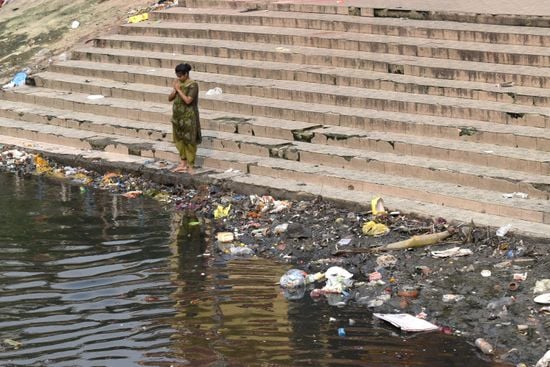Yamuna’s Floodplains Under Threat: Parliamentary Committee Raises Alarm on Encroachments
WATER


The Yamuna, one of India’s most significant water bodies, faces an existential crisis due to rampant encroachments along its floodplains as reported in the Parliamentary Standing Committee on Water Resources, chaired by Rajiv Pratap Rudy. The report has highlighted grave concerns regarding the degradation of the river’s ecological system. The committee’s findings underscore the failure of multiple states to furnish crucial data on floodplain encroachments and wetland management, raising questions about the commitment to preserving this critical natural resource.
The Lifeline of North India
Originating from the Yamunotri Glacier in Uttarakhand, the Yamuna flows across several states, covering a stretch of 1,376 kilometers before merging with the Ganges at Triveni Sangam in Prayagraj, Uttar Pradesh. The river’s basin spans Himachal Pradesh, Haryana, Delhi, Uttar Pradesh, Rajasthan, and Madhya Pradesh, supporting millions through drinking water, agriculture, and industrial use. However, despite its significance, unchecked urbanization and lax enforcement of environmental regulations have led to the widespread degradation of its floodplains.
Floodplains are an integral part of the riverine ecosystem, comprising wetlands, forests, and grasslands that work in tandem with the river. They recharge aquifers, mitigate floods, and provide a habitat for diverse flora and fauna. However, the committee’s findings reveal that state governments have been slow to act, putting the ecological integrity of Yamuna’s floodplains at severe risk.
Discrepancies in State Reporting: Who is Accountable?
During the committee’s assessment of encroachments along Yamuna’s floodplains, only two states—Delhi and Haryana—provided comprehensive data. The Department of Water Resources, River Development & Ganga Rejuvenation informed the committee that states like Uttarakhand, Himachal Pradesh, Uttar Pradesh, and Rajasthan had failed to furnish any information regarding encroachments in their respective regions. This lack of transparency raises concerns about whether adequate monitoring mechanisms exist in these states.
In Haryana, the total floodplain area of the Yamuna is 24,406 acres, distributed across Karnal (10,960 acres), Panipat (5,100 acres), and HKB Jagadhari (8,346 acres). The Haryana government, however, reported zero wetland encroachments, a claim that warrants further independent verification.
In Delhi, the total area designated as Zone ‘O’ (River Zone/floodplains) under the Master Plan Delhi-2021 (MPD-2021) is 9,700 hectares. However, only 1,675.10 hectares are available for restoration under Delhi Development Authority (DDA) supervision. The report identified 161.95 hectares as encroached floodplain land, with legal battles hindering eviction efforts.
Interestingly, the State of Uttar Pradesh admitted that it has not even demarcated the Yamuna’s floodplain zone, raising serious concerns about whether any conservation or anti-encroachment measures are being implemented. Furthermore, Himachal Pradesh has yet to submit any report on the status of its Yamuna floodplain region, despite multiple requests from the committee.
Delhi’s Encroachment Struggle: A Case Study in Delayed Action
Delhi, which sits along 22 km of the Yamuna, has faced significant encroachment challenges, particularly from informal settlements (Jhuggis/clusters). The DDA has successfully reclaimed 477.79 hectares of floodplain land, but litigation continues to obstruct further action. The National Green Tribunal (NGT) has directed authorities to accelerate restoration efforts, but progress remains slow.
Additionally, the total wetland area of the Yamuna in Delhi is 59.82 hectares, and while no encroachments were reported on wetlands, this data remains contested, given Delhi’s dense urban expansion.
The Parliamentary Standing Committee has urged the Department of Water Resources to:
Pressure the Himachal Pradesh government to submit details on floodplain encroachments.
Direct the Uttar Pradesh government to demarcate the floodplain zone of Yamuna.
Ensure that encroachments along the floodplains are systematically removed, especially in areas with legal obstructions.
Enhance inter-state coordination among Yamuna basin states to ensure a uniform approach to floodplain and wetland conservation.
The Yamuna’s floodplains are not merely vacant land ripe for development but a crucial ecological buffer that sustains millions of people. The failure of several states to report encroachments signals an urgent need for stronger enforcement of environmental regulations. With increasing urbanization and climate change threats, safeguarding the Yamuna’s floodplains is not just an ecological necessity but a matter of environmental justice and sustainability.
The findings presented in this report serve as a wake-up call for policymakers. If urgent action is not taken, the Yamuna—already declared ‘ecologically dead’ in Delhi—will see irreversible damage, further impacting water security, biodiversity, and flood resilience in North India. The government must now choose: to preserve the Yamuna’s natural ecosystem or allow unchecked urban expansion to push it beyond recovery.
